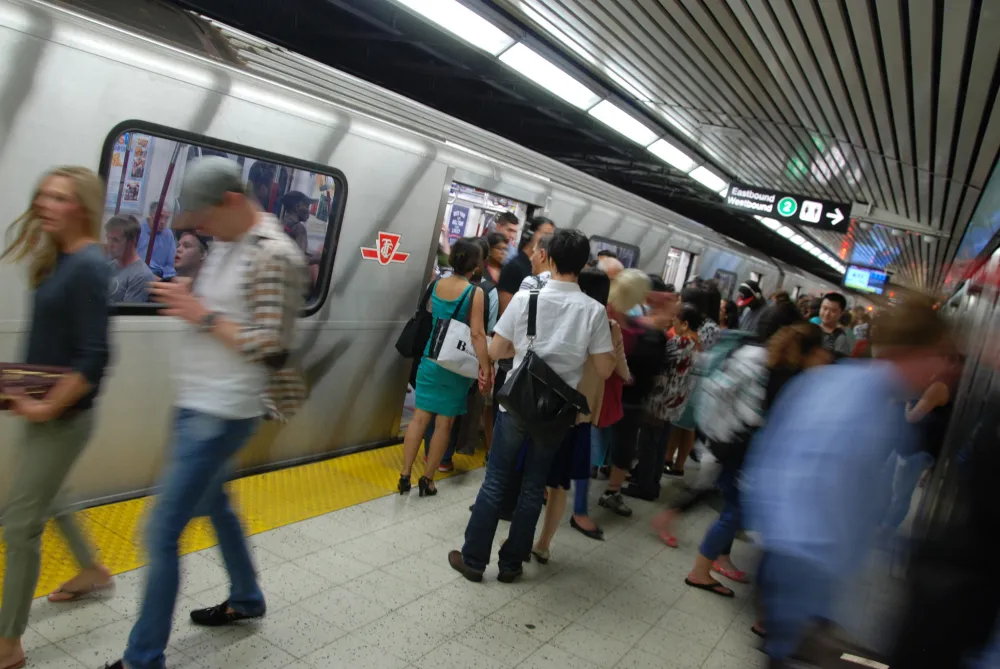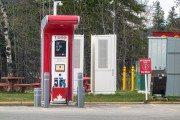Ontarians can all feel the pressure of growing cities — whether it’s through rising home ownership or rental costs, worsening air quality, congestion on the roads, or squeezing onto a packed subway car for your daily commute. As the population in the Greater Golden Horseshoe (GGH) is expected to grow by 50% — from 9 million today to 13.5 million in 2041 — cities need political leaders to double down on city planning efforts that support a growing population. One of the biggest concerns we have at the Pembina Institute is ensuring public transit investments are commensurate with a growing population — initiatives that generate the highest return for the greatest number of people. With the municipal election coming up on October 22, transit is a top issue that requires strong ideas and leadership from mayoral and council candidates across the GGH and in Ontario’s other growing cities.
One strategy to help cities fully realize the benefits of transit investments is through “transit-supportive development” or “transit-oriented development”, as we’ve previously written about. Along with our partners at Evergreen, we co-chair the Transit Supportive Working group – which brings together government and private sector leaders – as part of the Housing Action Lab. We’ve found that cities need strong municipal leadership that builds community around a modern and integrated transit system that works for today and the future. Here are three opportunities for municipal leadership on transit-supportive development.
The Strategic Opportunities Ahead
Opportunity 1: Creating a strong economy and attracting jobs
What’s at stake: Traffic congestion hampers our economic productivity and adds frustration and burden to our lives. The Toronto Board of Trade estimates that gridlock on highways in the Greater Toronto Area increases the cost of goods being delivered to stores, limits our productivity levels, and costs each household $125 a year.
A city that does not provide public transit and enough mobility choices can limit people’s access to employment opportunities. More often than not, it is those living in neighbourhoods without access to reliable and frequent transit that are missing out. Additionally, not having a well-connected transit system can affect whether businesses like Amazon choose to locate in the region, which could mean the region misses out on attracting thousands of jobs.
What to do about it: Greater attention is needed from municipal elected officials on strengthening planning and economic development investments around transit. Specifically, cities need to create public-private partnerships to anchor large office and institutional employers around mobility hubs to encourage transit ridership, or as Metrolinx calls it, Anchor Hubs. For example, in cities like Detroit and Boston, the public sector has found a new template to fund public transit and attract employment around transit stations. Through such partnerships, new train stops/stations can be built and operational at a fast pace, to provide service where it is desperately needed.
Research shows that investing in public transit and clustering development around transit pays off. When transit is a viable choice, it can reduce vehicle costs for households. Residents in transit-supportive development areas typically reduce single-occupant vehicle commuting to their workplace by 15-30%, about half of which shifts to transit. Shopify recently announced that it will invest up to $500 million in a new Toronto office – in an area with excellent access to transit - drawing in thousands of new employees. This is why significant focus and resources should remain dedicated towards attracting major investments like this not only in Toronto but also in areas around the region with access to transit, including GO commuter rail and affordable housing.
Opportunity 2: Save Ontarians from paying higher infrastructure costs
What’s at stake: Despite intensification policies to target growth and development in urban centres in the Growth Plan for the GGH, urban sprawl continues at a rapid pace. Continued urban sprawl in areas without existing services and infrastructure, including public transit can result in higher municipal infrastructure and operational costs that overburdens taxpayers in the long-term.
What to do about it:
Gentle re-development in low-rise neighbourhoods near transit
Municipal elected officials need to show leadership that targets growth and development around transit in both urban and suburban communities — and to demonstrate it doesn’t exclusively mean high-rise development. It can mean more modest and gentle densities in low-rise neighbourhoods, where it makes sense. Cities can learn from Vancouver’s Making Room housing strategy, which includes a focus on redeveloping neighbourhoods at appropriate scales. Recently, Vancouver’s city council approved zoning changes that would allow duplexes throughout the city to incrementally add more density to single family neighbourhoods to ease housing demand. This strategy can be adapted to the GGH context and applied to specific areas around transit corridors and stations to accommodate more families in neighbourhoods with access to frequent and rapid transit service. The Ryerson City Building Institute’s new report indicates opportunities for cities to meet intensification targets in the Growth Plan for the GGH, to address “missing middle” housing challenges by redeveloping around existing and future planned transit corridors and stations.
Re-develop underutilized and vacant land
As a part of the strategy to accommodate more housing and employment in our region, municipal elected officials need to make small steps to redevelop underutilized and vacant parcels of land in urban centres to better leverage investments in transit and encourage transit ridership. One example is to redevelop free surface parking lots around transit stations (including GO stations) into places where people can work, shop and dine, pick-up groceries, or pick-up kids at daycare. While they may serve a purpose in the short-term (e.g., allows commuters to park and take transit), over time this land use should be activated and better integrated into a vibrant and buzzing community.
Opportunity 3: Cleaning our air and improving public health
What’s at stake: With more than 63% of people driving during peak hours in the GTHA, the number of cars on the road has environmental implications. As of 2015, the transportation sector is the second highest emitting sector in the GTHA, accounting for 33% of the total emissions. Emissions generated by cars and trucks also add to other contaminants, polluting air and affecting our health. The Medical Officers of Health (MOH) have estimated that traffic-related emissions in the GTHA were responsible for over 700 premature deaths each year, with an economic impact of over $4.6 billion in health-related costs.
What to do about it:
Increasing walking and biking paths and amenities, and ridesharing connections
Municipal elected officials must take actions that make public transit more attractive to commuters by integrating safe and easy to use walking and cycling paths and ridesharing connections in and around transit stations. These are not new ideas but where we still need municipal leadership and bold action. By providing a suite of mobility choices that complement public transit, commuters can travel seamlessly for the first and last leg of their journey. The benefits of providing an integrated mobility system are more than convenience and transit ridership. The same MOH report reports that an increase use of public transit and active transportation in the GTHA can result in preventing premature deaths, diabetes, heart and lung conditions, and other chronic diseases.
Build up zero- and low-emission transit fleets
In parallel with this work, municipal elected officials need to fully explore how to reduce transportation-related GHG emissions by testing and advancing wide-scale adoption of zero and low emission transit fleets. Municipal leaders can learn from other Canadian cities such as Vancouver who have aspirational plans to exclusively purchase zero-emission vehicles after 2025 and Edmonton who have plans to exclusively purchase electric buses after 2020.
Looking Forward
It’s clear that growing cities can bring a lot of opportunities — if investments are done well. The three opportunities above are examples of how to build neighbourhoods to not only accommodate for the housing supply that is needed while also capitalizing on existing and future planned transit infrastructure. This is a tough challenge, but as this blog outlines, the opportunities are too great to be missed, and the solutions are within reach. What we need now is to see how municipal leaders are going to demonstrate strong leadership and bold action to create the cities we need.







